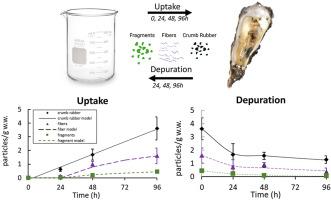Environmental Pollution ( IF 7.6 ) Pub Date : 2022-06-25 , DOI: 10.1016/j.envpol.2022.119681 John E Weinstein 1 , Bonnie M Ertel 1 , Austin D Gray 2

|
Along the South Carolina coast (U.S.) where the ecologically and economically important eastern oyster (Crassostrea virginica) forms extensive intertidal reefs, recent surface water surveys found that fibers, fragments, and microscopic tire particles represented 43.6%, 30.9%, and 17.7% of the total microplastics, respectively. The aim of this study was to characterize accumulation and depuration of these particles in eastern oysters. Oysters were exposed to purple polyethylene fibers, green nylon fragments, or micronized crumb rubber at a concentration of 5000 microplastics/L, and sacrificed after 0, 24, 48, and 96 h to characterize uptake. Following 96 h, remaining oysters were transferred to microplastic-free brackish water and sacrificed at 24, 48, and 96 h to characterize depuration. For fibers and fragments, levels increased in a nonlinear fashion reaching 1.61 ± 0.6 particles/g w. w. (mean ± SE) and 0.46 ± 0.1 particles/g w. w. after 96 h, respectively. Conditional uptake clearance rate constants (ku) were estimated to be 0.0084 and 0.0025 mL/g*h for fibers and fragments, respectively. For crumb rubber, levels increased in a linear fashion reaching 3.62 ± 0.8 particles/g w. w. after 96 h, and the ku value was estimated to be 0.0077 mL/g*h. Depuration was best described using a two-compartment (double exponential) model suggesting the presence of fast and slow compartments. Conditional depuration rate constants (kd) for the slow compartments were 0.0084, 0.0205, and 0.0048/h for fibers, fragments, and crumb rubber, respectively. These results demonstrate accumulation and depuration of microplastics in eastern oysters is size-and shape-dependent. Depuration, which is a common practice for shellfish safety, is an effective way to reduce microplastic loads in eastern oysters, but the minimum recommended time of 44 h would only reduce loads of these particles by 55.5–67.6%.
中文翻译:

东部牡蛎(Crassostrea virginica)中微塑料纤维、碎片和轮胎颗粒的积累和净化:毒代动力学方法
沿着南卡罗来纳州海岸(美国),那里有生态和经济上重要的东部牡蛎(Crassostrea virginica) 形成广泛的潮间带礁,最近的地表水调查发现,纤维、碎片和微小的轮胎颗粒分别占微塑料总量的 43.6%、30.9% 和 17.7%。这项研究的目的是描述这些颗粒在东部牡蛎中的积累和净化。牡蛎暴露于浓度为 5000 微塑料/L 的紫色聚乙烯纤维、绿色尼龙碎片或微粉化橡胶屑中,并在 0、24、48 和 96 小时后处死以表征吸收情况。96 小时后,将剩余的牡蛎转移到不含微塑料的微咸水中,并在 24、48 和 96 小时处死以表征净化。对于纤维和碎片,水平以非线性方式增加,96 小时后分别达到 1.61 ± 0.6 个颗粒/g ww(平均值 ± SE)和 0.46 ± 0.1 个颗粒/g ww。k u ) 估计纤维和碎片分别为 0.0084 和 0.0025 mL/g*h。对于碎橡胶,96 小时后水平以线性方式增加,达到 3.62 ± 0.8 个颗粒/g ww,并且k u值估计为 0.0077 mL/g*h。使用表明存在快速和慢速隔间的双隔间(双指数)模型最好地描述净化。条件净化率常数 ( k d) 对于慢速隔室,纤维、碎片和碎橡胶的速度分别为 0.0084、0.0205 和 0.0048/h。这些结果表明东部牡蛎中微塑料的积累和净化取决于大小和形状。净化是贝类安全的常见做法,是减少东部牡蛎中微塑料负荷的有效方法,但建议的最短 44 小时时间只会将这些颗粒的负荷减少 55.5-67.6%。









































 京公网安备 11010802027423号
京公网安备 11010802027423号